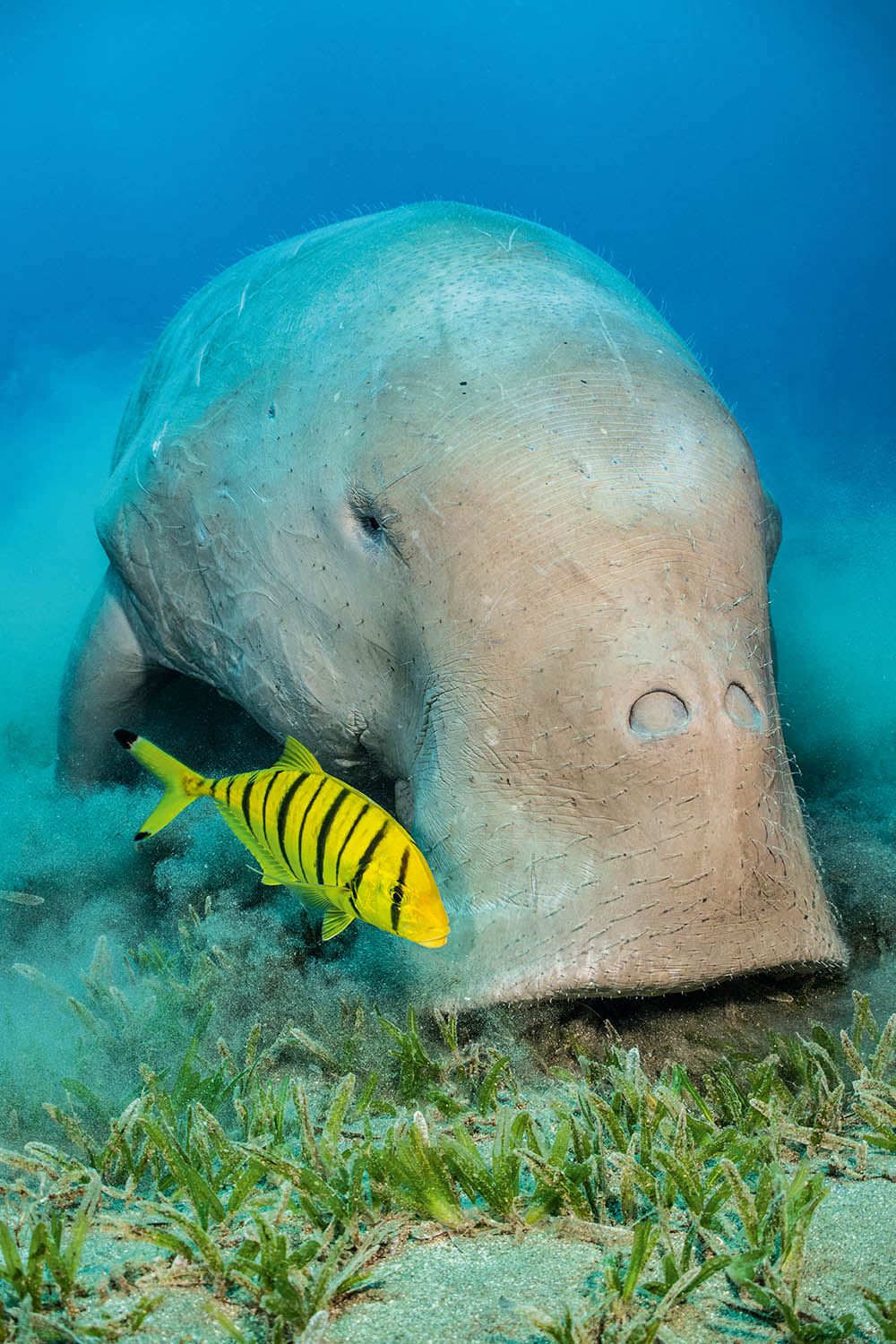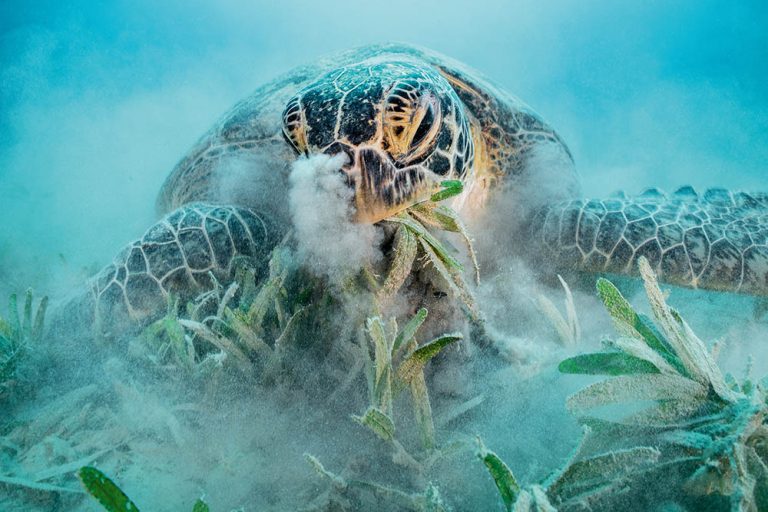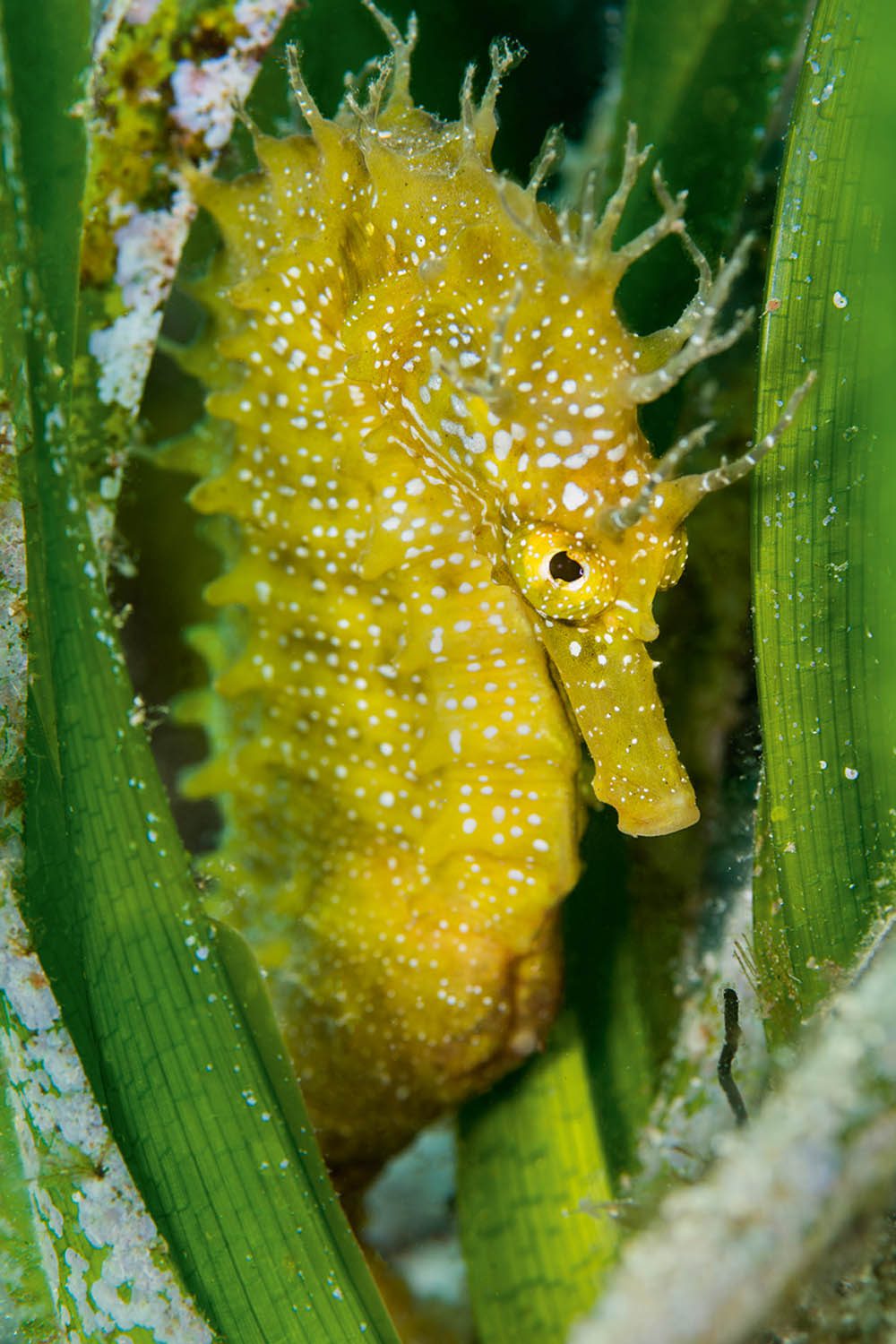PHOTO TECHNIQUE
Be The Champ!
Continuing his ‘fieldcraft’ mini-series on the techniques to employ to get the best images of iconic marine species, ALEX MUSTARD turns his attention to a habitat too easily overlooked by divers – seagrass beds
’Seagrass can seem a desert of photographable life –
but whoever said that winning images were easy to get!’

A dugong munches seagrass, accompanied by a golden trevally.
Taken with a Nikon D850 and Nikon 28-70mm with Nauticam WACP. Subal housing.
2 x Seacam strobes. 1/125th @ f/14, ISO 320.
The current theme of Be The Champ! is fieldcraft, as we look in detail at how the natural factors, that go beyond camera settings, can turn average wildlife pictures into amazing images.
Underwater photography has always been a technical discipline, which tends to leave photographers so concerned with technique that we can miss the bigger picture of what we’re trying to achieve. If we want to shoot great photos of underwater wildlife, we need to understand it.
Fieldcraft isn’t about being a fish-ID bookworm, but about knowing the where and when of finding subjects, how to approach them properly, and what techniques and compositions will show them off to the max.
It is a subject-specific understanding and affinity for nature that has a positive effect on our pictures.
Appeared in DIVER December 2019
Seagrass meadows are among the ocean’s most important habitats, and are found from the Equator to high latitudes. Yet they are regularly ignored by underwater photographers in favour of the simpler pleasures of nearby coral and rocky reefs.
While reefs hum with life and photo-opportunities seem inexhaustible, seagrass can at first glance seem a desert of photographable life.
But whoever said that winning pictures were easy to get! I hope that this month’s column makes your seagrass dives more productive.
Seagrass is very different to other ocean plants, which are all types of algae – from the huge giant kelps to single-celled phytoplankton.
Seagrass is a flowering plant, a descendant of land plants that has colonised beneath the waves, taking the same evolutionary journey from land to ocean as turtles, dugongs and others.
Its meadows are a vital nursery-ground for many fish species. Thirty times more species can be found within them than on adjacent sandy areas, and they protect our coastlines from erosion.
STARTER TIP
Dugongs are endangered and rare animals. Chasing after them while they are travelling does not yield the right images.
Much better to pay more, go with a naturalist guide and just a couple of divers and try to find one busy feeding, when even a short session will yield memorable images.
Perhaps their star turn is in helping us in the fight against global warming by absorbing carbon dioxide and locking it away in the sediment – something they do 35 times faster even than tropical rainforests.
And I suspect that you will not be surprised to learn that this habitat, just like our rainforests, is under threat from human activities across the world – with a hectare being destroyed every hour of every day.
Scientists and conservation groups are taking the problem seriously. For example, the UK has lost 92% of its seagrass in the past century and WWF, Sky Ocean Rescue and Swansea University have joined forces to reseed a new meadow in Wales.
As photographers, we can help too. Even divers don’t think seagrass is sexy, but when we can create eye-catching images of meadows and the species that live there, our images will reach out and help convince the general public to care.
Seagrass itself is hardly a dream photographic subject, but because of its importance we should still try to produce attractive images. Meadows photograph best when we shoot towards the sun – the colour and texture of leaves comes through far better this way.
In shallow, calm water, where seagrass often thrives, we can also incorporate attractive sunbursts and sun-rays, especially when the sun is low in the sky.
Some species of seagrass grow right up to the surface, and on windless days this can create mesmerising reflections.
Timing our photography for low tide will accentuate this effect, looking especially good if we shoot with a rectilinear (non-fisheye) wide-angle lens.
That said, the main photographic attraction of seagrass is the collection of creatures that live there. When I’m planning a seagrass dive, it’s a benefit to recalibrate my expectations from a reef dive. On seagrass I should be hoping for just one or two good-quality subjects, and will probably have to dedicate far more time to searching than shooting.
Seagrass is home to a wide diversity of macro subjects, including fabulous cryptic invertebrates, including sea-slugs and crustaceans.
Seagrass leaves often photograph a dull green in macro pictures, but will look bright and attractive with light coming through them. The fancy solution is to use backlighting in our macro shots, the easier alternative is to shoot balanced-light pictures, allowing the ambient light into our images. Both work well.
Divers always associate seagrass with seahorses, because almost every seagrass conservation project is underpinned with images of these wonderfully sculpted fish. Seahorses do live in seagrass, but it’s actually one of the more difficult habitats in which to find them because the meadow provides endless hiding places.
Local knowledge is our best bet, so we should go with whoever knows precisely where one lives. Seahorses are usually territorial and stick in the same area for weeks, at least.
MID-WATER TIP
Seahorses are notoriously shy, so getting good eye contact is our first priority. Sometimes they are relaxed and will look at the lens, but more typically they will turn away.
Patience is key. Diving with a buddy can help and if you both approach from different sides the seahorse will end up facing one of you!
When I lived in Italy, I learned that the best way to find seahorses in a new seagrass area was to dive at night, when they come to the edges of clumps to feed, and are more easily spotted.
Once I knew the spot, I could return and invest time with them in daylight.
megafauna gets divers excited, and is the main draw for exploring seagrass in many areas. In tropical and sub-tropical waters green turtles are the dominant seagrass munchers, chomping through 2kg of grass each day.
Though we regularly encounter green turtles resting on the reef, the seagrass buffet is where we’ll get action shots.
All turtles are covered in quite-reflective scales, so when I spot one my first thought is to click my strobes down a notch. When I see a green turtle, I also remember that they have great facial expressions, even when shot with macro lenses. Youngsters also have very attractive shell markings, and can look great photographed from above, while large adults usually have remoras.
Feeding greens are easily approached, but we should take our time because we don’t want to disrupt their behaviour or stir up any sediment. I love shooting them when they’re making a mess. The worse their table manners the more interesting our shots will be, with seagrass hanging out of their mouths and enveloped in clouds of sediment.
Top trump of seagrass dives is the dugong. Worldwide this endangered and distant relative of the elephant is sparsely distributed and rarely encountered. But the popular coast of the Egyptian Red Sea, north and south of Marsa Alam, is probably the best place in the world to see them, though it still takes some dedication and a fair slice of luck.
I suggest going with a naturalist guide, who will snorkel as you dive. Stay on the boat until you see a dugong, and follow until it reaches its feeding grounds.
Travelling dugongs offer little more than a flyby. But once they’re feeding, you can easily capture great behaviour and portraits.
A snorkel guide can swim above the dugong, keeping it in sight until you’re ready to jump, and track it should it out-swim you when it surfaces to breathe!
Dugongs typically feed for about five minutes between breaths, giving lots of time for shots. I like seeing the full shape of the snout, so time my shots when it momentarily comes up off the seabed.
And because most are accompanied by juvenile golden trevallies, I will always try and include these pretty fish in my compositions.
ADVANCED TIP
Messy seagrass feeding shots look great. Backscatter isn’t usually a problem, as long as we get close and use just a tickle of flash. Make a feature of the clouds of sediment, which look best photographed against a slightly over-exposed background, which also helps hide any backscatter. It gives our images a totally different feel from anything shot on the reef.



